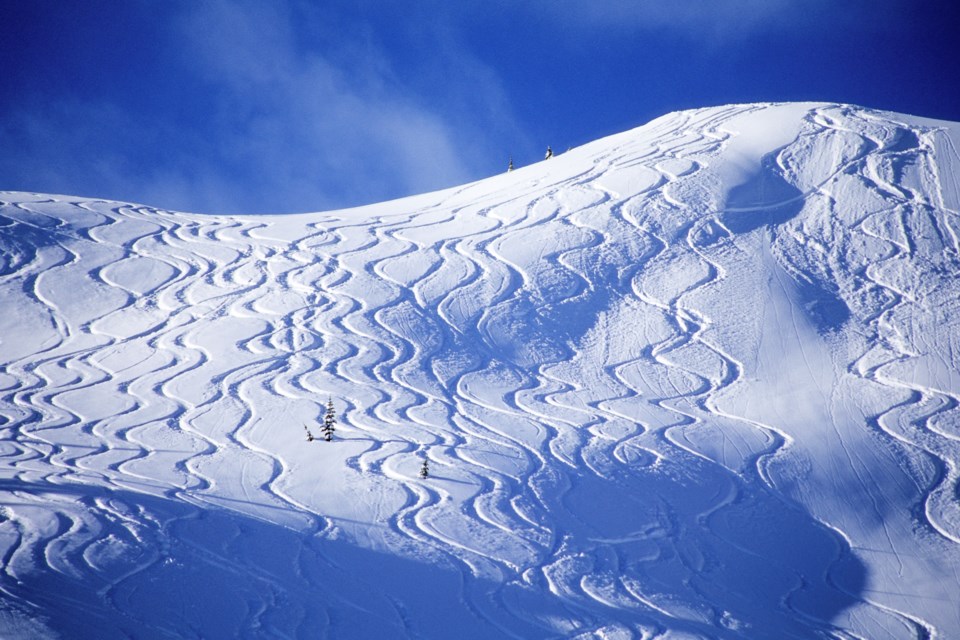If the first half of this season is an anomaly and not the harbinger of warm, dry winters punctuated by the occasional blizzard, this region is eventually going to have to have a hard talk about snow—specifically how our love for the powdered variety has resulted in lift lines stretching as far as the eye can see anytime we get a modest dump. Four good runs in five hours is not good value for anybody.
It hasn’t been a weekend-only thing for years, although weekends are definitely worse. There are clearly enough season-ticket holders in Whistler, Pemberton and Squamish to track out all 7,200 hectares of terrain and all the gaps in between in a few short hours without a single weekender or tourist joining the mayhem.
In fact, absent of real data, I would guess Whistler Blackcomb is more of a local mountain than ever, and passholders with regional addresses make up the vast majority of skiers and snowboarders on the mountains on any given pow day.
It was inevitable. The population of the Sea to Sky region is growing in leaps and bounds, adding to the pool of diehard skiers and boarders every year. Most people would grudgingly accept the added traffic and longer lift lines are an inevitable part of this growth, reasoning—correctly—that it’s still better than living somewhere flat, even if things feel more crowded. Having to wait 40 minutes in a lift line to get a second run is the most first-world of all first-world problems.
But it’s also clear to me the lines are getting longer, even if they’re moving faster with increased upload capacity, and that something has to give. I used to be able to sneak in seven or eight runs in the first two hours after the lifts cracked, now I’m lucky to get five. It definitely doesn’t help that I’ve been to other resorts where lift lines are relatively short and fresh powder can last for days instead of hours—nobody is panicking and everyone is happy. There’s no lift line at 6:30 a.m., or even 7:30 a.m., and you get strange looks from the lifties if you show up 15 minutes early.
This isn’t meant to be a complaint, because I’m very much part of the problem, the same way you’re never actually stuck in traffic because you are the traffic. It’s just that every year it seems to get tighter with more and more diehards angling for the same lines, getting up earlier and earlier to stake out a spot. Powder mornings (I can’t call them “days” anymore) just aren’t what they used to be. The mountains are no longer big enough for all of us.
Which raises the question: besides complaining, what can we do about it?
Assuming again that skiing has a future at all given the progression of climate change, how do we meet the demand for powder in a way that visitors will continue to come here without being turned off by the crowds, long lines or the—let’s be generous and call it “intensity”—of thousands of local powder hounds?
Can we add a third mountain somewhere? More lift-assisted backcountry opportunities? More lifts on the terrain we already have, with more runs within the existing ski-area boundary? Can we maybe expand those boundaries a little?
Will Garibaldi at Squamish, if someone buys it out of receivership, divert enough of the total traffic coming to Whistler to make a difference? And for how long before the continued population growth leaves us in the same boat?
There are already long-term plans to develop the West Bowl-Bagel Bowl area of Whistler and, with a little summer grooming, there used to be runs in the Peak to Creek zone that could definitely be better utilized. There were plans for a lift in West Bowl, as well as a plan to create another upload zone at the entrance to Cheakamus Crossing that I don’t think will ever happen given the terrain, south-facing aspect, altitude, and limited space to build a new base area.
Expanding within the boundaries has pluses and minuses. Expanding the alpine areas increases the area that needs avalanche control, and further delays the opening of the alpine. Adding more runs and glades below the treeline, along with new lifts and lap-able zones, can help spread people out, but snow isn’t guaranteed at lower altitudes. At the end of the day, we’re still talking about tens of thousands of people. Expansion will help, but will it be enough?
One option that could work, or at least relieve lines of the most hardcore skiers and boarders, would be an experts-only, lift-assisted backcountry experience similar to Silverton in Colorado.
Silverton has only a few cut runs, accessible from a single lift that runs to the top of an alpine ridge with mostly natural terrain below. It also requires you to ski with a guide from December to March, which wouldn’t fly here, but we could get around that by requiring members to take a safety tour of the mountain, have at least a Level 1 avalanche safety course, wear working avalanche transceivers to get on the lift, and wear tracking devices similar to those used by the Whistler Kids program that could alert officials when someone is still on the mountain at end of day or has gotten themselves into trouble.
There aren’t many mountains close enough to the highway to work—Brandywine, Powder, and Rainbow Mountains are the obvious choices, although there are a few other options on both sides of Whistler.
I know it’s not something that could happen overnight, it would just be nice to know that something is in the works. I can only set my alarm so early.




